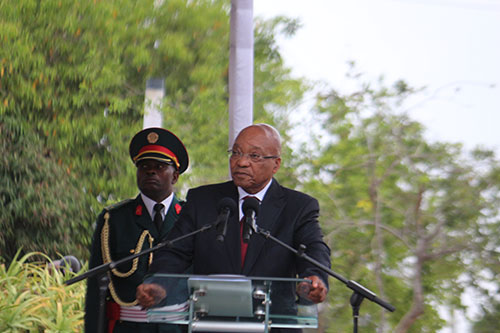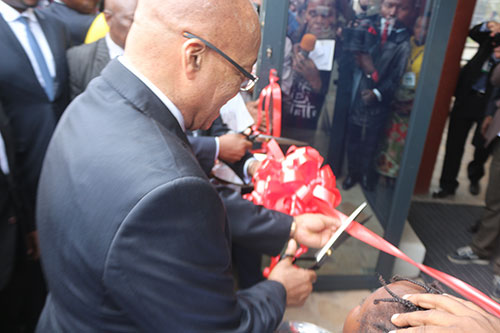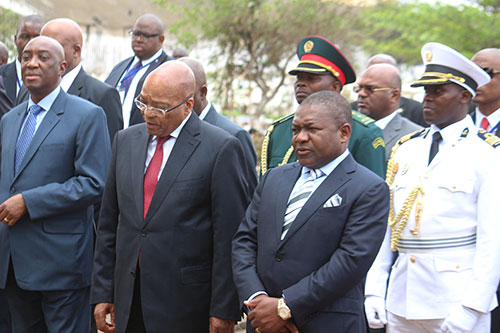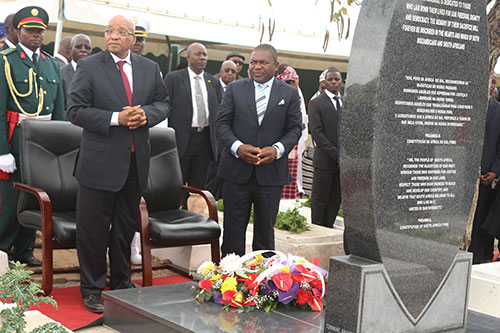

11 September 2015
As part of Heritage Month in September, President Jacob Zuma and his Mozambican counterpart unveiled the Matola Memorial Monument and Interpretative Centre in Mozambique on 11 September 2015. This memorial honours the fallen heroes of the Matola raid as well as paying homage to the sacrifices and contributions made by the Mozambicans towards a free, non-racial and democratic South Africa.

On 30 January 1981 the South African National Defence Force of the then apartheid government raided the African National Congress safe houses in Matola, a suburb in the outskirts of Maputo. These safe houses served as transit points for uMkhonto Wesizwe (MK) cadres.
During the raid 12 MK members and one Mozambican citizen were instantly killed. Another MK member, Mduduzi Sibanyoni, later died of injuries sustained during the raid.
According to the Truth and Reconciliation Commissions records, two additional MK combatants who had been abducted during the raid were later brutally killed at the Vlakplaas Camp. A Mozambican was also reportedly abducted.
The raid constituted part of the apartheid destabilisation campaign against countries and peoples who supported the liberation struggle. Similar raids and assassinations were also conducted in Zimbabwe, Angola, Swaziland, Zambia, Lesotho and France among others.
On 14 February 1982, on the first commemoration event of the Matola raid, the late Mozambican President Samora Machel called for this day to be declared as the day of friendship between the two neighbours.
In honour and memory of the fallen heroes and their affected families of the Matola raid, the South African and Mozambican governments initiated a project in 2002 to construct a monument and interpretation centre at Matola to commemorate the events of 1981.


Former Minister of Arts and Culture Pallo Jordan approved the project in 2008 with the sod turning ceremony taking place in July 2009. A Memorandum of Understanding between the two governments was also signed in 2011 to pave the way for the establishment of commemoration structures. This was followed by the laying of the foundation stone on 8 July 2011.
The South African Defence Force (SADF), through the State Security Council (SSC), carried out a number of attacks on ANC houses in Mozambique over a period of three years. Cross border raids by the SADF took three basic forms. One of the methods used was assassinations through car and parcel bombs - attacks were either made on ANC offices or alternatively the bomb was sent directly to the ANC representative. Another method was sending in commandos across borders - this involved gathering of intelligence on liberation movement activities and then sending in a group of commandos from the SADF to destroy infrastructure and kill political activists. Lastly, the government allowed abductions or kidnappings of political activists who were then secretly transported back to South Africa for interrogation or trial. The activists could also be turned into an askari (an agent of the government masquerading as a member of the liberation movement).
On the morning of 30 January 1981 SADF commandos drove 70kms across the South African-Mozambican border to Matola, a suburb in Maputo. The suburb contained a number of houses that served as safe houses or operational bases for MK. They attacked and destroyed three houses and killed 16 South Africans and a Portuguese national, Jose Ramos, who bore a striking resemblance to Joe Slovo. For brief period the SADF celebrated the death Slovo before news of the true identity of the Portuguese national emerged.
At one of the houses, the ANC fought back and killed two commandos and injuring others. One of the commandos killed was a British mercenary named Robert Lewis Hutchinson who had served in the British Army and the Rhodesian Special Air Service before moving to South Africa. Hutchinson was wearing a helmet with a swastika and a slogan which read ‘Sieg Heil’, which was a Nazi salute. The other commando was Ian Suttill who shared a similar military background with Hutchinson.
The MK members who were killed include Lancelot Hadebe, Mandla Daka, Daniel Molokisi, Steven Ngcobo, Vusumzi Ngwema, Thabang Bookolane, Krishna Rabilal, Themba Dimba, Motso Mokgabudi, Collin Khumalo, Levinson Mankankaza, Albert Mahutso and William Khanyile. The president of the ANC, Oliver Tambo, in the company of Mozambican president, Samora Machel, addressed mourners on 14 February 1981, at the funeral of those who were killed. As a result, the day was declared the Day of Friendship between South African and Mozambique. The January 1981 Matola raid was not the only raid conducted by the SADF. On 29 May 1983 jets deployed by the South African Airforce carried out ‘Operation Skerwe’ and attacked Matola and Liberdade, suburbs of Maputo. After the raid the SADF claimed it had destroyed ANC bases and killed 41 'ANC terrorists'.
The raid had however failed as it killed three workers arriving for work at the Somopal jam factory. At least 40 other people, mostly women and children, were injured by shrapnel. The SADF justified the raid by stating that it was retaliation for the explosion of bombs planted by the ANC in Pretoria which killed 16 people and injured 130 people on 20 May 1983. Two of the targets for the explosions were the South African Air Force Headquarters and the Military Intelligence and Naval Offices in downtown Pretoria.
Full article: SA History Online


The initiative of establishing the Department of Military Veterans forms part of government's commitment to support and recognise Military Veterans for their contribution to bring about the realisation of a peaceful, democratic and prosperous South Africa.
A dignified, unified, empowered and self-sufficient military veterans’ community.
To facilitate delivery and co-ordinate all activities that recognise and entrench the restoration of dignity and appreciation of the contribution of Military Veterans to our freedom and nation building.